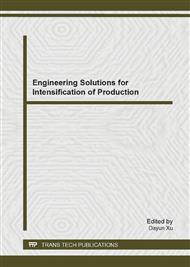[1]
J. Martinez Herrera, A. L. Martinez Ayala, G. Francis, K. Becker, Agro-climatic condition, chemical and nutritional characterization of different provenances of Jatropha curcas from Mexico, European Journal of Scientific Research, Vol. 39 (2010).
Google Scholar
[2]
Martinez Herrera J., Siddhuraju P., Francis G., Davila-Ortiz G., Becker K., Chemical composition, toxianti metabolic constituents and the effect of different treatments on their levels in four provenances of Jatropha curcas L. from Mexico, Journal: Food and Chemistry. Vol. 96 (2006).
DOI: 10.1016/j.foodchem.2005.01.059
Google Scholar
[3]
Martínez Herrera J., El Piñon Mexicano una alternativa Bionergenitca para México, Revista digital Universitaria, Coordinación de publicación digitales DGSCA-UNAM., Vol. 8 (2007) No. 1210.
Google Scholar
[4]
Y. Vacknin, M. Ghanim, S. Samra, L. Dvash, E. Hendelsman, D. Eisikowitch, Y. Samocha, Predicting Jatropha curcas seed-oil composition and protein content using near-infrared spectroscopy- A quick and non-destructive method, Industrial Crops and products, Available on line 3 april , (2011).
DOI: 10.1016/j.indcrop.2011.03.011
Google Scholar
[4]
N. H. Jayadas Prabhakaran, K. Nair, G., Ajaith Kumar, Tribological evolution of coconut oil as an environment friendly lubricant. Tribology International 40 (2007) 350-354.
DOI: 10.1016/j.triboint.2005.09.021
Google Scholar
[5]
T.P. Murali, S.V. Prasad, M.K. Surappa, P.K. Rohatgi, K. Gopinath, Friction and wear behaviour of aluminium alloy coconut shell char particulate composites, Wear, 80 (1982), 149-158.
DOI: 10.1016/0043-1648(82)90214-9
Google Scholar
[6]
K. Cheenkahorn, D. Fungtammsan, Development of engine oil using palm oil as a base stock for four balls stroke engines. Energy 35 (2010) 2252-2556.
DOI: 10.1016/j.energy.2010.03.002
Google Scholar
[7]
Y. Wang, J.E. Fernandez, D.G. Cuervo, Rolling, Contact fatigue life on the steels AISI 52100 balls with eight mineral and synthetic lubricants, Wear 196 (1996) 110-119.
DOI: 10.1016/0043-1648(95)06857-0
Google Scholar
[8]
M. Figueroa, Diseño mecánico integral y manufactura de los componentes mecánicos de máquina tribológica de cuatro bolas para ensayos lubricados. (2009).
Google Scholar
[9]
E. Garcia, Diseño mecánico integral y manufactura de los componentes mecanicos de máquina tribológica de cuatro bolas para ensayos lubricados. (2009).
Google Scholar
[10]
W. Piekoszewski, M. Szczerek, W. Tuszynki, The action of lubricants under extreme pressure conditions in a modified four ball tester, Wear 249 (2001) 188-193.
DOI: 10.1016/s0043-1648(01)00555-5
Google Scholar
[11]
Y. ChunDe, Z. ZhiHui, X. Yuanli, H. Yu, Experimental investigation of effects of bio-additives on fuel economy of gasoline engine, Science in China series E: Technological Science Vol. 51 (2008) No. 8 1177-1185.
DOI: 10.1007/s11431-008-0170-1
Google Scholar
[12]
The effect of palm oil diesel fuel contaminated lubricant on sliding wear of cast irons against mild steel., Masjuki H. H., Meleque M A., Wear 198 (1996) 293-299.
DOI: 10.1016/0043-1648(96)07208-0
Google Scholar
[13]
A. Hayyan, M. Zahangir Alam, M. E. S. Mirghani, N. A. A., Kabbashi., Nazashida Mohd Hakimi, Y. M., Siran., Tahiruddin S., Sludge palm oil as a renewable raw material for biodiesel production by two-steps process., BiousourceTechnolgy Vo. 101, 2010, 7804-7811.
DOI: 10.1016/j.biortech.2010.05.045
Google Scholar
[14]
A.S.M.A. Haseeb, S.Y. Sia, M. A. Fazal, H. H. Masjuki, Effect on temperature on tribological properties of palm biodiesel, Energy 35 (2010) 1460-1464.
DOI: 10.1016/j.energy.2009.12.001
Google Scholar
[15]
J. Qian,H. Shi, Z, Yun, Preparation of Biodiesel from Jatropha curcas L. oil produced by two-phase solvent extraction, Biosource technology.
DOI: 10.1016/j.biortech.2010.04.018
Google Scholar
[16]
M, K. Lam, K. T. Lee, Renewable and sustainable bioenergies production from palm oil mill effluent (POME): Win-win strategies toward better environmental protection, Biothecnlogy advances Availablre on line.
DOI: 10.1016/j.biotechadv.2010.10.001
Google Scholar


